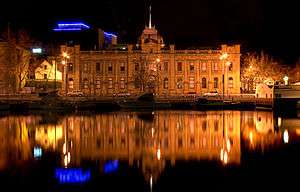Alan Cameron Walker
Alan Cameron Walker (1865–1931) was an Australian architect and philanthropist, born in Hobart, Tasmania. The grandson of John Walker, he was educated at Hutchins School and apprenticed to Henry Hunter. He produced many Tasmanian government and other buildings during his career, and was also a keen silversmith, serving as President of the Tasmanian Arts and Crafts Society for 25 years. He was the first President of the Tasmanian Architect's Registration Board.[1]
Life

Walker was born in 1865, fourth son of Herbert Walker. He was educated at the Hutchins School.[1]
Walker was apprenticed to Henry Hunter. Upon completion of his apprenticeship, he studied in Britain under Professor Roger Smith and then worked for Sir Banister Fletcher recording sketches of historic British buildings. He was admitted an associate to the Royal Institute of British Architects and upon return to Australia he worked for the architectural firm of Ellerker & Kilburn in Melbourne. He then worked on his own, during which time he served on the council of the Royal Victorian Institute of Architects. He returned to Tasmania in 1895, six years after marrying Mabel Robertson. Mabel's mother and sister were lost with the SS Waratah.[2] He had two children with Mabel, Huon Walker and C.N Walker, who married a Dr Atkins. Mabel would die in 1918.[3]
In Tasmania he designed several major public buildings, as well as supervising major additions to St David's Anglican Cathedral, and was active in the arts community. He married his second wife Daisy Hook in 1922. He was part of the organising committee of an antique exhibition in aid of employment in 1931.[3] He was a collector of Australian native plants, and also worked to establish bush gardens at the Mount Wellington springs.[3]
Death
Walker died on 12 December 1931 of Valvular heart disease.[4] Walker was buried in Cornelian Bay cemetery[3] Upon his death, his will was valued at net of £31,565.[5] His will was appealed to the High Court by his wife Daisy regarding whether or not the £1000 annuity he had left her required her to live in his home of Huonden.[6] When she was unsuccessful an appeal was then submitted to the Privy Council but dismissed.[7]
Legacy
The Alan Cameron Walker shield was awarded by the Arts and Craft Society for some years. It was won permanently by Friends' School, Hobart in 1936.[8] A silver altar cross, designed by Walker, was dedicated to him at St David's Cathedral, Hobart in 1932.[9]
Architectural works
- Hobart General Post Office[1]
- Werndee (home of Premier of Tasmania Elliott Lewis)[4]
- Old State Library (now Carnegie Building, Maritime Museum of Tasmania)[10]
- St Raphael's, Fern Tree[11]
- National Mutual Life Building, Hobart[12]
- St David's Cathedral, Hobart cloisters addition[1]
- Commercial Travelers Club, Launceston (demolished)[13]
- Springs Hotel, Mt Wellington (destroyed, 1967 Tasmanian fires)[14]
- St Peter’s Catholic Church, Kempton, Tasmania[15]
Silversmithing
Walker was noted for his success in silversmithing, though he did it primarily as a hobby. A coffee pot fashioned by him is exhibited in the Art Gallery of South Australia.[16]
References
- "OBITUARY". The Mercury. Hobart, Tas.: National Library of Australia. 14 December 1931. p. 6. Retrieved 10 January 2015.
- "PERSONAL". Mercury (Hobart, Tas. : 1860 - 1954). 30 January 1932. p. 8. Retrieved 27 July 2020.
- "OBITUARY". Mercury (Hobart, Tas. : 1860 - 1954). The Mercury. 14 December 1931. p. 6. Retrieved 27 July 2020.
- Lennard, Brendan; Miley, Caroline (1990). Walker, Alan Cameron (1864–1931) – Australian Dictionary of Biography. National Centre of Biography. Retrieved 10 January 2015.
- "TASMANIAN WILLS". The Mercury. Hobart, Tas.: National Library of Australia. 11 February 1933. p. 8. Retrieved 11 January 2015.
- "ARGUMENT ON TERMS OF WILL". The Mercury. Hobart, Tas.: National Library of Australia. 18 March 1953. p. 13. Retrieved 11 January 2015.
- "WORLD DIGEST". The Courier-Mail. Brisbane: National Library of Australia. 31 October 1953. p. 4. Retrieved 11 January 2015.
- "ARTS AND CRAFTS". Mercury (Hobart, Tas. : 1860 - 1954). The Mercury. 30 October 1936. p. 7. Retrieved 27 July 2020.
- "CHURCH NEWS & NOTES". Mercury (Hobart, Tas. : 1860 - 1954). 12 December 1932. p. 2.
- "ALAN CAMERON WALKER". utas.edu.au. University of Tasmania. Retrieved 10 January 2015.
- "St Raphael's Fern Tree". allsaints-southhobart.org.au. Anglican Parish of All Saint's, South Hobart. Retrieved 10 January 2015.
- "National Mutual Life Building, Hobart, Tasmania". ausmed.arts.ewa.edu.au. Medievalism in Australian Cultural Memory Project. Retrieved 10 January 2015.
- "150 years" (PDF). architectsdesignhaus.com. CRAWFORD PADAS SHURMAN ARCHITECTS. Retrieved 27 October 2015.
- "Historical Notes of Wellington Park" (PDF). wellingtonpark.org.au. Wellington Park Trust. Retrieved 13 November 2015.
- "(Former) St Peter's Catholic Church, Kempton, Tasmania". ausmed.arts.uwa.edu.au. Medievalism in Australian Cultural Memory. Retrieved 24 March 2016.
- "WALKER, Alan Cameron Australia, 1864–1931 Coffee pot". artgallery.sa.gov.au. Art Gallery of South Australia. Retrieved 11 January 2015.